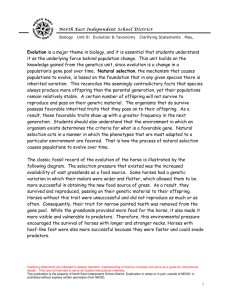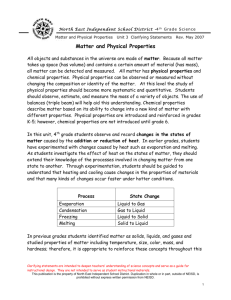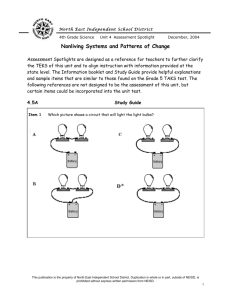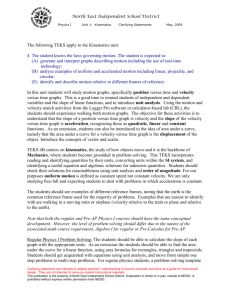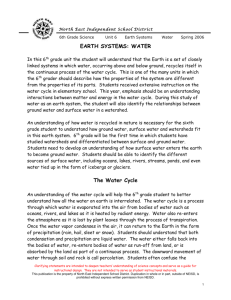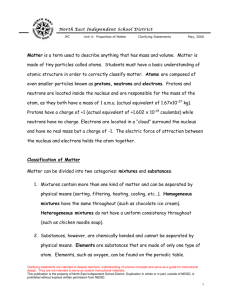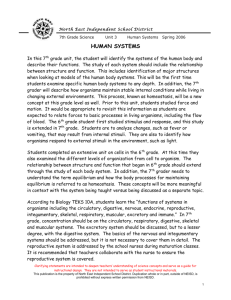Changes in Matter - North East Independent School District
advertisement
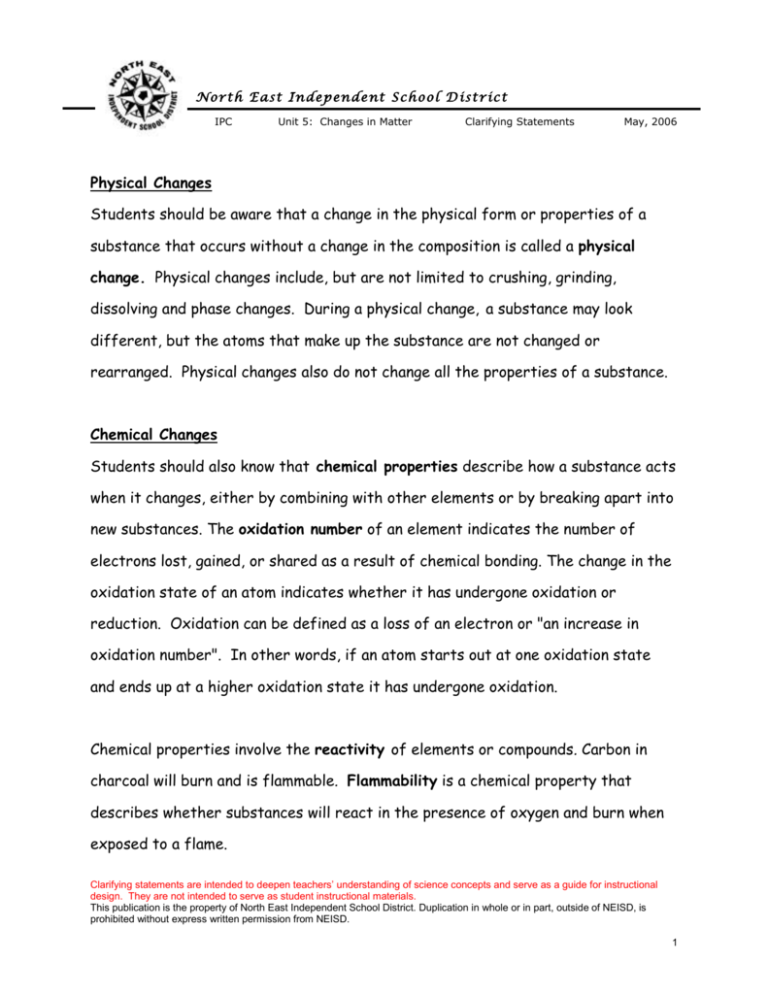
N o r t h E a st I n d ep en d e nt S c h o o l D i st ric t IPC Unit 5: Changes in Matter Clarifying Statements May, 2006 Physical Changes Students should be aware that a change in the physical form or properties of a substance that occurs without a change in the composition is called a physical change. Physical changes include, but are not limited to crushing, grinding, dissolving and phase changes. During a physical change, a substance may look different, but the atoms that make up the substance are not changed or rearranged. Physical changes also do not change all the properties of a substance. Chemical Changes Students should also know that chemical properties describe how a substance acts when it changes, either by combining with other elements or by breaking apart into new substances. The oxidation number of an element indicates the number of electrons lost, gained, or shared as a result of chemical bonding. The change in the oxidation state of an atom indicates whether it has undergone oxidation or reduction. Oxidation can be defined as a loss of an electron or "an increase in oxidation number". In other words, if an atom starts out at one oxidation state and ends up at a higher oxidation state it has undergone oxidation. Chemical properties involve the reactivity of elements or compounds. Carbon in charcoal will burn and is flammable. Flammability is a chemical property that describes whether substances will react in the presence of oxygen and burn when exposed to a flame. Clarifying statements are intended to deepen teachers’ understanding of science concepts and serve as a guide for instructional design. They are not intended to serve as student instructional materials. This publication is the property of North East Independent School District. Duplication in whole or in part, outside of NEISD, is prohibited without express written permission from NEISD. 1 N o r t h E a st I n d ep en d e nt S c h o o l D i st ric t IPC Unit 5: Changes in Matter Clarifying Statements May, 2006 Physical and chemical properties can be used to determine the function of a substance. Copper is used in electrical power lines, telephone lines, and electric motors because of its good electrical conductivity. Antifreeze, which contains ethylene glycol (a poisonous liquid), remains a liquid at temperatures that would otherwise freeze or boil the water in a car radiator. This is the reason it is added to a radiator in order to keep it from freezing in winter or boiling over in summer. Chemical Changes A change that occurs when a substance changes composition (by forming one or more new substances) is known as a chemical change. Examples of chemical changes are digestion, burning of gasoline, fermentation, and the ripening of fruit. In each case of a chemical change, a new substance is formed. Students must recognize the evidence of a chemical changes which include: absorption or release of heat (temperature changes) formation of a precipitate change in odor color change production of a gas (bubbles) A chemical change also occurs when a compound breaks apart to form at least two other pure substances. An example of this type of chemical change is the Clarifying statements are intended to deepen teachers’ understanding of science concepts and serve as a guide for instructional design. They are not intended to serve as student instructional materials. This publication is the property of North East Independent School District. Duplication in whole or in part, outside of NEISD, is prohibited without express written permission from NEISD. 2 N o r t h E a st I n d ep en d e nt S c h o o l D i st ric t IPC Unit 5: Changes in Matter Clarifying Statements May, 2006 electrolysis of water, which results in the formation of hydrogen and oxygen gas molecules. These molecules are not created or destroyed, but are instead simply rearranged from the original water molecules. Many hunters and skiers use heat packs to keep their hands and feet warm. These heat packs contains a sodium acetate crystallization and re-solution system that is an example of a chemical change. By bending the metal disc in the bag, the sodium acetate crystallizes and gives off heat. Placing the bag in boiling water redissolves the sodium acetate, and the bag can then be reused. Cold packs often contain the chemical ammonium nitrate as it absorbs a great deal of heat when it is dissolved in water. When ammonium nitrate dissolves in water, it creates an endothermic reaction. Water and ammonium nitrate are contained in separate chambers in the pack until they are broken. This causes the ammonium nitrate to dissolve in the water, absorbing heat and causing the pack to grow as cold as zero degrees Celsius. The law of conservation of energy The energy of a system may take various forms such as kinetic, potential, heat, or light energy. The law of conservation of energy states that in any physical and chemical change, energy is neither created nor destroyed. Students must know that although energy may be converted from one form to another during a physical Clarifying statements are intended to deepen teachers’ understanding of science concepts and serve as a guide for instructional design. They are not intended to serve as student instructional materials. This publication is the property of North East Independent School District. Duplication in whole or in part, outside of NEISD, is prohibited without express written permission from NEISD. 3 N o r t h E a st I n d ep en d e nt S c h o o l D i st ric t IPC Unit 5: Changes in Matter Clarifying Statements May, 2006 or chemical change, the total amount of energy before and after the change is always constant. Energy Changes Accompanying Chemical Reactions Up to this point students have used the terms endothermic and exothermic referring to reactions where heat energy is gained or released (thermic = heat). From this point forward the terms endergonic and exergonic will be used to refer to the total energy gained or released (light, electrical, mechanical, etc…) Bonding Atoms bond with each other by transferring or sharing electrons in the outermost energy level. These outermost electrons, known as valence electrons, determine the element’s properties. A substance composed of a single type of atom is known as an element, and may be bonded together into molecules or crystalline solids. A compound is formed when two or more kinds of atoms chemically bond together. Students must be aware that atoms join to form bonds in order for each atom to fill its outermost energy level. When this occurs, each atom has a structure similar to that of a noble gas, where each outermost energy level contains eight valence electrons. Some bonds are stronger and more rigid than others; yet all bonds behave more like flexible springs than like sticks. Clarifying statements are intended to deepen teachers’ understanding of science concepts and serve as a guide for instructional design. They are not intended to serve as student instructional materials. This publication is the property of North East Independent School District. Duplication in whole or in part, outside of NEISD, is prohibited without express written permission from NEISD. 4 N o r t h E a st I n d ep en d e nt S c h o o l D i st ric t IPC Unit 5: Changes in Matter Clarifying Statements May, 2006 Students must also be familiar with ionic bonds which are formed between oppositely charged ions such as a metal and a nonmetal. Atoms of metal elements, such as sodium and calcium, lose valence electrons to form positively charged ions. Atoms of nonmetal elements, such as chlorine and oxygen, gain valence electrons to form negatively charged ions. Ionic bonds are formed by the transfer of electrons until both ions fill their outermost energy levels. These oppositely charged ions then attract each other and form an ionic bond. An important property of ionic bonds is that when melted or dissolved in water, ionic compounds conduct electricity. Students must be able to write ionic formulas, and may find the criss-cross method helpful. To make sure that the positive charge(s) and negative charge(s) cancel each other out, the magnitude of the charges are criss-crossed in the final formula of the compound. An example follows below: Ca 2+ Cl 1- CaCl2 Ionic compounds are named according to the following convention: sodium and chlorine (NaCl): sodium chloride In other words, the name of the metal is followed by the name of the non-metal with its ending altered to be -ide. Clarifying statements are intended to deepen teachers’ understanding of science concepts and serve as a guide for instructional design. They are not intended to serve as student instructional materials. This publication is the property of North East Independent School District. Duplication in whole or in part, outside of NEISD, is prohibited without express written permission from NEISD. 5 N o r t h E a st I n d ep en d e nt S c h o o l D i st ric t IPC Unit 5: Changes in Matter Clarifying Statements May, 2006 Students must also be aware that covalent bonds are often formed between nonmetal atoms that share their valence electrons. These atoms don’t transfer electrons to one another because each needs to gain at least one electron to complete an energy level. If each atom shares at least one electron with the other atom, then both atoms full their outermost energy level together. Atoms may share more than one pair of electrons but do not always share electrons equally. An unequal sharing of electrons forms a polar covalent bond, where the shared electrons are attracted to the nucleus of one atom more than the other. Most covalent molecules have low melting points due to the nature of their bonds. Covalently bonded atoms are usually located closer together on the periodic table than the atoms of ionic compounds. The covalent bond between two chlorine atoms (Cl2) is shown below. The naming of covalent molecules may be introduced so that students can correctly identify covalent molecules (It is not necessary to go in depth). Covalent compounds are named by adding a prefix to the second non-metal in order to indicate how many atoms of this element are present in the compound. Clarifying statements are intended to deepen teachers’ understanding of science concepts and serve as a guide for instructional design. They are not intended to serve as student instructional materials. This publication is the property of North East Independent School District. Duplication in whole or in part, outside of NEISD, is prohibited without express written permission from NEISD. 6 N o r t h E a st I n d ep en d e nt S c h o o l D i st ric t IPC Unit 5: Changes in Matter Clarifying Statements May, 2006 For example: sulphur difluoride (SF2) phosphorus trichloride (PCl3) sulphur tetrafluoride (SF4) phosphorus pentachloride (PCl5) Some compounds contain both ionic and covalent bonds. Polyatomic ions are groups of covalently bonded atoms that act as an ion unit. Students should understand the concept of polyatomic ions, but should not be tested on their identity. A table of familiar polyatomic ions follows: Ion name Formula Ion name Formula ammonium ion NH41+ hydroxide ion OH1- phosphate ion PO43- nitrate ion NO31- carbonate ion CO32- sulfate ion SO42- Clarifying statements are intended to deepen teachers’ understanding of science concepts and serve as a guide for instructional design. They are not intended to serve as student instructional materials. This publication is the property of North East Independent School District. Duplication in whole or in part, outside of NEISD, is prohibited without express written permission from NEISD. 7 N o r t h E a st I n d ep en d e nt S c h o o l D i st ric t IPC Unit 5: Changes in Matter Clarifying Statements May, 2006 The law of conservation of mass The law of conservation of mass states that mass is neither created nor destroyed. Students must understand that this law holds true for both physical and chemical changes as although matter may change from one form to another, its total mass remains the same. The mass of substances produced by a chemical reaction (the products) is always equal to the mass of the initial reacting substances (the reactants). Chemical equations must therefore be balanced in order to obey the law of conservation of mass. Balancing equations is the process of adding coefficients to the left of symbols and formulas in order to ensure that the total mass of each element is that same before and after the reaction. coefficient subscript Zn + 2HCl ---> ZnCl2 + H2 Reactants: on the left Ingredients that enter a reaction Products: on the right The outcome of a reaction. YIELD S Clarifying statements are intended to deepen teachers’ understanding of science concepts and serve as a guide for instructional design. They are not intended to serve as student instructional materials. This publication is the property of North East Independent School District. Duplication in whole or in part, outside of NEISD, is prohibited without express written permission from NEISD. 8 N o r t h E a st I n d ep en d e nt S c h o o l D i st ric t IPC Unit 5: Changes in Matter Clarifying Statements May, 2006 Students may find the following steps helpful when balancing chemical equations: 1. List each element vertically under the yield arrow. 2. List the total number of atoms in the product (multiply the coefficients by the subscripts). 3. Change the coefficients until there is an equal number of each type of atom on each side of the equation. 4. Check your answer by counting atoms. Types of Reactions Students should be familiar with the following types of reactions: 1. Synthesis (addition) reactions produce compounds. Two or more substances combine to form a new compound. A general equation for a synthesis reaction is: A+ B AB An example of a synthesis reaction is the formation of rust. Fe(s) + O2(g) Fe2O3(s) 2. A decomposition reaction is a chemical reaction in which a single compound is broken down to produce two or more compounds. A general decomposition reaction is: AB A+B An example of a decomposition reaction is the decomposition of baking soda with heat: NaHCO3(s) 2H2(g) + O2(g) Clarifying statements are intended to deepen teachers’ understanding of science concepts and serve as a guide for instructional design. They are not intended to serve as student instructional materials. This publication is the property of North East Independent School District. Duplication in whole or in part, outside of NEISD, is prohibited without express written permission from NEISD. 9 N o r t h E a st I n d ep en d e nt S c h o o l D i st ric t IPC Unit 5: Changes in Matter Clarifying Statements May, 2006 3. In a single-replacement (displacement) reaction, one element replaces another in a compound. A general equation for a single-replacement reaction is: AB + C CB + A A single-replacement reaction occurs when an iron nail is placed in a beaker of copper (II) chloride: Fe(s) + CuCl2 (aq) FeCl2(aq) + Cu(s) 4. In a double-replacement (displacement) reaction, ions from two compounds in solution exchange places to produce two new compounds. A general equation for a double-replacement reaction is: AB + CD AD + CB The reaction between lead (II) nitrate and potassium iodide is an example of a double-replacement reaction. Pb(NO)3(aq) + 2KI(aq) PbI2(s) + 2KNO3(aq) 5. In a combustion reaction, a substance combines with oxygen to release energy. A general equation for a combustion reaction is: Carbon compound + O2 CO2(g) + H2O(g) An example is the combustion of natural gas to heat a house. CH4 + 2O2 CO2 +2H2O Clarifying statements are intended to deepen teachers’ understanding of science concepts and serve as a guide for instructional design. They are not intended to serve as student instructional materials. This publication is the property of North East Independent School District. Duplication in whole or in part, outside of NEISD, is prohibited without express written permission from NEISD. 10 N o r t h E a st I n d ep en d e nt S c h o o l D i st ric t IPC Unit 5: Changes in Matter Clarifying Statements May, 2006 Nuclear Changes Protons and neutrons are tightly packed into the tiny nucleus of an atom. The process of splitting open this nucleus is called fission. Students must be aware that during fission, the nucleus breaks into smaller nuclei and releases a large amount of energy in the process (this energy was formerly holding the nucleus together). Students should be familiar with the following particles and energy that may be released as nuclear radiation: 1. alpha particles - helium nuclei 2. beta particles – high energy electrons 3. gamma rays – extremely high energy electromagnetic waves 4. neutrons Students must also know that when nuclei combine to form larger nuclei, fusion occurs. Stars, including the sun, obtain their primary source of energy from the fusion of hydrogen. Fusion reactions produce even more energy than fission reactions. Radioactive substances can be highly useful. Some of their uses are as follows: 1. Small radioactive sources are used to detect smoke particles in smoke alarms. 2. Gamma rays are used during nuclear radiation therapy when they are focused to kill tumor cells. Clarifying statements are intended to deepen teachers’ understanding of science concepts and serve as a guide for instructional design. They are not intended to serve as student instructional materials. This publication is the property of North East Independent School District. Duplication in whole or in part, outside of NEISD, is prohibited without express written permission from NEISD. 11 N o r t h E a st I n d ep en d e nt S c h o o l D i st ric t IPC Unit 5: Changes in Matter Clarifying Statements May, 2006 3. Radioactive isotope tracers can be used in agriculture, medicine, and scientific research. Radioactive tracers are short-lived isotopes which trace the path of a specific substance. 4. Present day nuclear reactors use the process of fission to produce energy in order to generate electricity. Nuclear fission does not produce gaseous pollutants, and there is much more energy in the known uranium reserves than in the known reserves of coal and oil. Radioactive substances can produce negative effects. 1. The outer skin protects the body from low levels of nuclear radiation. Higher levels of nuclear radiation however, can cause burns in the skin and can destroy bone marrow cells (which form red and white blood cells). 2. High concentrations of radon gas may cause lung cancer. 3. Nuclear radiation can cause genetic mutations. Long-term effects of nuclear radiation appear when DNA molecules in the body are damaged. 4. Radiation sickness may occur from exposure to a single massive release such as a nuclear explosion (ex: Hiroshima and Nagasaki), or it may occur after repeated exposure to even very small doses such as in a plant or laboratory. 5. Exposure to the ultraviolet radiation of the sun can cause tissue destruction and trigger mutations that can lead to skin cancer. Clarifying statements are intended to deepen teachers’ understanding of science concepts and serve as a guide for instructional design. They are not intended to serve as student instructional materials. This publication is the property of North East Independent School District. Duplication in whole or in part, outside of NEISD, is prohibited without express written permission from NEISD. 12 N o r t h E a st I n d ep en d e nt S c h o o l D i st ric t IPC Unit 5: Changes in Matter Clarifying Statements May, 2006 6. Nuclear waste (a byproduct of fission) must be handled carefully so it does not escape into the environment and release nuclear radiation. 7. The fission process of a nuclear reactor produces particles that may cause a chain reaction. A nuclear reactor must be equipped with many safety features (such as control rods) to prevent a reactor failure. Clarifying statements are intended to deepen teachers’ understanding of science concepts and serve as a guide for instructional design. They are not intended to serve as student instructional materials. This publication is the property of North East Independent School District. Duplication in whole or in part, outside of NEISD, is prohibited without express written permission from NEISD. 13
